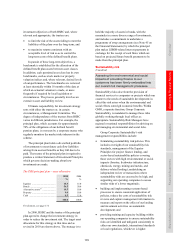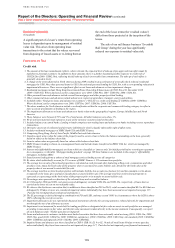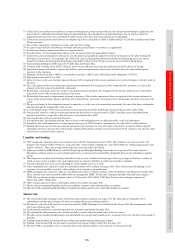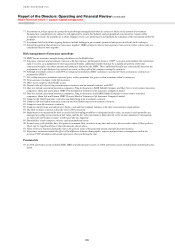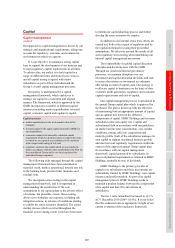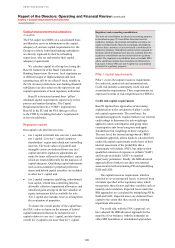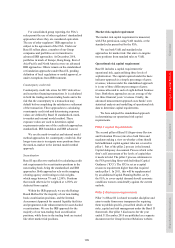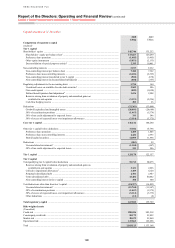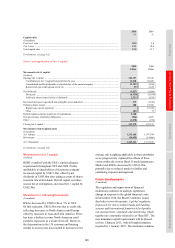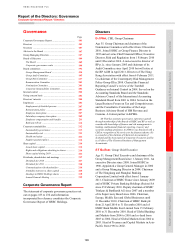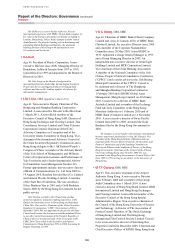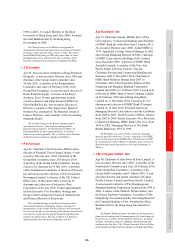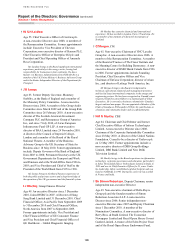HSBC 2010 Annual Report Download - page 184
Download and view the complete annual report
Please find page 184 of the 2010 HSBC annual report below. You can navigate through the pages in the report by either clicking on the pages listed below, or by using the keyword search tool below to find specific information within the annual report.
HSBC HOLDINGS PLC
Report of the Directors: Operating and Financial Review (continued)
Capital > Future developments // Governance > Corporate Governance Report / Directors
182
equity tier 1 requirement of 4.5% and additional
capital conservation buffer requirement of 2.5% will
be phased in sequentially from 1 January 2013,
becoming fully effective on 1 January 2019. Any
additional countercyclical capital buffer requirements
will also be phased in, starting in 2016, in parallel
with the capital conservation buffer to a maximum
level of 2.5% effective on 1 January 2019, although
individual jurisdictions may choose to implement
larger countercyclical capital buffers. The leverage
ratio will be subject to a supervisory monitoring
period, which commenced on 1 January 2011, and a
parallel run period which will run from 1 January
2013 until 1 January 2017. Further calibration of the
leverage ratio will be carried out in the first half of
2017, with a view to migrating to a pillar 1
requirement from 1 January 2018. The Basel
Committee has increased the capital requirements
for the trading book and complex securitisation
exposures which are due to be implemented on
31 December 2011. They will continue to conduct
the fundamental review of the trading book, which
is targeted for completion by the end of 2011. In
addition to the reforms discussed above, institutions
designated as G-SIFIs may be subjected to additional
requirements, which have yet to be proposed by
regulators. The Basel Committee will provide the
approach to defining G-SIFIs by the end of 2011.
On 13 January 2011, the Basel Committee issued
further minimum requirements to ensure that all
classes of capital instruments fully absorb losses
at the point of non-viability before taxpayers are
exposed to loss. Instruments issued on or after
1 January 2013 may only be included in regulatory
capital if the new requirements are met. The capital
treatment of securities issued prior to this date will
be phased out over a 10-year period commencing
1 January 2013.
Impact of Basel III
(Unaudited)
In order to provide some insight into the possible
effects of the new Basel III rules on HSBC, we have
estimated the pro forma common equity tier 1 ratio
of the Group on the basis of our interpretation of
those rules, as they would apply at 1 January 2019,
but based on the position at 31 December 2010.
We have estimated that the application of the full
Basel III rules on a pro forma basis would result in a
common equity tier 1 ratio which is lower than the
Basel II core tier 1 ratio by some 250–300 basis
points. However, as the new rules will be phased in
between 1 January 2013 and 1 January 2019, their
impact will be gradual over that period. This
estimate does not, however, take account of any
future retained earnings, nor any management
actions to reduce RWAs. The Basel III changes
relate to increased capital deductions, new regulatory
adjustments and increases in RWAs. The majority of
the increase in RWAs relates to Basel III changes
which are scheduled to come into effect on 1 January
2013, in particular to changes to counterparty credit
risk capital charges and amounts for securitisation
positions that were previously deducted from capital
that will now be risk-weighted instead. Other
increases in RWAs will begin to be phased in from
1 January 2014, including the majority of the
unconsolidated investments that were previously
deducted from capital. The remainder of the RWA
increase arises from increases in trading book capital
requirements which take effect on 31 December
2011, primarily relating to changes in market risk.
The estimated impact of Basel III is subject to
change as regulators develop their requirements
around the practical application and interpretation of
the new rules, in particular the counterparty credit
risk capital charge. Further uncertainty remains
regarding any capital requirements which may be
imposed on the Group over the period to 1 January
2019 in respect of the countercyclical capital buffer
and any additional regulatory requirements for
G-SIFIs. Under the Basel III rules as they will apply
from 1 January 2019, we believe that ultimately the
level for the common equity tier 1 ratio of the Group
may lie in the range 9.5% to 10.5%. This exceeds the
minimum requirement for common equity tier 1
capital plus the capital conservation buffer. HSBC
has a strong track record of capital generation and
actively manages its RWAs. Before these new
rules come into force, we will take appropriate
management action over the implementation period
to 1 January 2019 to reduce the quantum of increase
in RWAs that would have occurred if the new rules
had been in effect at 31 December 2010.
Footnotes to Capital
1 Includes externally verified profits for the year to 31 December 2010.
2 Mainly comprises unrealised losses on available-for-sale debt securities within special purpose entities which are excluded from the
regulatory consolidation.
3 Under FSA rules, unrealised gains/losses on debt securities net of tax must be excluded from capital resources.
4 Under FSA rules, the defined benefit liability may be substituted with the additional funding that will be paid into the relevant schemes
over the following five year period.
5 Mainly comprise investments in insurance entities.
6 Under FSA rules, collective impairment allowances on loan portfolios on the standardised approach are included in tier 2 capital.
7 Rights issue excludes US$493m of losses arising on derivative contracts and certain fees, which are recognised in the income statement.



